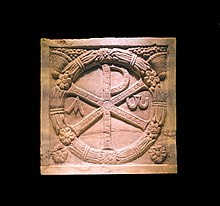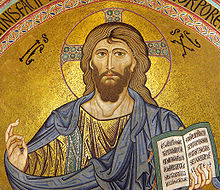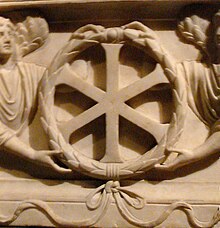Christogram: Difference between revisions
toc |
|||
| Line 10: | Line 10: | ||
[http://ducange.enc.sorbonne.fr/CHRISMON1 1 chrismon] (par les Bénédictins de St. Maur, 1733–1736), in: du Cange, et al., ''Glossarium mediae et infimae latinitatis'', ed. augm., Niort : L. Favre, 1883‑1887, t. 2, col. [http://media.enc.sorbonne.fr/ducange/jpg/C/318c.jpg 318c], |
[http://ducange.enc.sorbonne.fr/CHRISMON1 1 chrismon] (par les Bénédictins de St. Maur, 1733–1736), in: du Cange, et al., ''Glossarium mediae et infimae latinitatis'', ed. augm., Niort : L. Favre, 1883‑1887, t. 2, col. [http://media.enc.sorbonne.fr/ducange/jpg/C/318c.jpg 318c], |
||
citing Heumann. de re Diplom. inde a Carol. M. § 12; Murator. Antiquit. Ital. tom. 3. col. 75. |
citing Heumann. de re Diplom. inde a Carol. M. § 12; Murator. Antiquit. Ital. tom. 3. col. 75. |
||
</ref> |
|||
One of the oldest Christograms is the [[Chi-Rho]]. It consists of the superimposed Greek letters [[Chi (letter)|chi]] {{lang|grc|(Χ)}} and [[Rho (letter)|rho]] {{lang|grc|(Ρ)}}, which are the first two letters of Christ in Greek. It was displayed on the ''[[labarum]]'' military standard used by [[Constantine I]] in AD 312. The [[IX monogram]] is a similar form, using the first Greek letters in "Jesus Christ". |
One of the oldest Christograms is the [[Chi-Rho]]. It consists of the superimposed Greek letters [[Chi (letter)|chi]] {{lang|grc|(Χ)}} and [[Rho (letter)|rho]] {{lang|grc|(Ρ)}}, which are the first two letters of Christ in Greek. It was displayed on the ''[[labarum]]'' military standard used by [[Constantine I]] in AD 312. The [[IX monogram]] is a similar form, using the first Greek letters in "Jesus Christ". |
||
== |
==Chi (X)== |
||
{{see|Chi (letter)}} |
|||
| ⚫ | The most commonly encountered Christogram in English-speaking countries in modern times is the X (or more accurately, the Greek letter chi), representing the first letter of the word ''Christ'', in such abbreviations as ''[[Xmas]]'' (for "Christmas") and ''[[Xian (abbreviation)|Xian]]'' [[Xian (abbreviation)|or ''Xtian'']] (for "Christian"). |
||
==Chi Rho (XP)== |
|||
| ⚫ | In [[Eastern Christianity]], the most widely used Christogram is a four-letter abbreviation, '''ΙϹΧϹ''' — a traditional abbreviation of the [[Greek language|Greek]] words for "Jesus Christ" (i.e., the first and last letters of each of the words {{lang|grc|ΙΗΣΟΥΣ ΧΡΙΣΤΟΣ}} — written "ΙΗϹΟΥϹ ΧΡΙϹΤΟϹ" with the [[sigma (letter)#Lunate sigma|lunate sigma]] "Ϲ" common in medieval Greek).<ref>''Symbols of the Christian faith'' by Alva William Steffler 2002 ISBN 0-8028-4676-9 page 67</ref> |
||
{{main|Chi Rho}} |
|||
| ⚫ | [[File:Chrismon Sancti Ambrosii.jpg|thumb|A [[Chi Rho]] combined with [[Alpha and Omega]], in 1669 labelled ''Chrismon Sancti Ambrosii'', [[Milan Cathedral]].<ref>The symbol was moved to storage for the refurbishments under [[Pellegrino Tibaldi]] and re-instated in the choir on 6 September 1669. ([http://www.storiadimilano.it/cron/dal1651al1675.htm storiadimilano.it]).<!--the point being that this is a 17th-century attestation of "chrismon"--> |
||
| ⚫ | |||
| ⚫ | Use of the name ''Chrismon'' is apparently based on the term ''crismon'' as used by [[Landulf of Milan]] ([http://www.mlat.uzh.ch/MLS/xfromcc.php?tabelle=Landulfus_Mediolanensis_cps2&rumpfid=Landulfus_Mediolanensis_cps2,%20Historia%20Mediolanensis&id=Landulfus_Mediolanensis_cps2,%20Historia%20Mediolanensis&corpus=2&lang=0&von=overview_by_author I.12]). Landulf's mention of a ''crismon'' of [[Saint Ambrose]] clearly refers to [[chrism]], i.e. holy oil, not a symbol. |
||
| ⚫ | |||
| ⚫ | |||
| ⚫ | |||
| ⚫ | |||
| ⚫ | Because the ''chrismon'' was used as a kind of "invocation" at the beginning of documents of the [[Merovingian period]], the term also came to be used of the "[[cross-signature]]s" in early medieval charters.<ref>while in English literature of the 19th to mid 20th century, ''chrismon'' refers to the Chi Rho monogram exclusively, the German-language usage has also come to be adopted in some cases in the specific context of medieval sigla, especially in works translated from German into English, e.g. |
||
| ⚫ | Hans Belting, Edmund Jephcott (trans.), ''Likeness and Presence: A History of the Image Before the Era of Art'' (1997), pp. 107-109. For German usage, see Ersch ''et al''., Volume 1, Issue 29 of ''Allgemeine Encyklopädie der Wissenschaften und Künste'', 1837, [https://books.google.com/books?id=sgxJAAAAcAAJ&pg=PA303#v=onepage&q&f=false p. 303] {{de icon}}. |
||
| ⚫ | |||
| ⚫ | |||
| ⚫ | ''Chrismon'' in this context may refer to the [[Merovingian period]] abbreviation ''I. C. N.'' for ''in Christi nomine'', later (in the [[Carolingian period]]) also ''I. C.'' for ''in Christo'', and still later (in the high medieval period) just ''C.'' for ''Christus''.<ref>Johann Christoph Gatterer, '' Abriß der Diplomatik'' (1798), |
||
| ⚫ | |||
| ⚫ | |||
==IHS== |
|||
==Western Christianity== |
|||
In the [[Latin]]-speaking Christianity of medieval Western Europe (and so among Catholics and many [[Protestant]]s today), the most common Christogram became "IHS" or "IHC", denoting the first three letters of the [[Greek language|Greek]] name of Jesus, IHΣΟΥΣ, ''[[iota]]-[[eta (letter)|eta]]-[[sigma (letter)|sigma]]'', or {{lang|grc|ΙΗΣ}}.<ref name=Gieben >''Christian sacrament and devotion'' by Servus Gieben 1997 ISBN 90-04-06247-5 page 18</ref><ref name=Becker >''The Continuum encyclopedia of symbols'' by Udo Becker 2000 ISBN 0-8264-1221-1 page 54</ref><ref name=CathHoly >[http://www.newadvent.org/cathen/07421a.htm Catholic encyclopedia: Holy Name of Jesus]</ref> |
In the [[Latin]]-speaking Christianity of medieval Western Europe (and so among Catholics and many [[Protestant]]s today), the most common Christogram became "IHS" or "IHC", denoting the first three letters of the [[Greek language|Greek]] name of Jesus, IHΣΟΥΣ, ''[[iota]]-[[eta (letter)|eta]]-[[sigma (letter)|sigma]]'', or {{lang|grc|ΙΗΣ}}.<ref name=Gieben >''Christian sacrament and devotion'' by Servus Gieben 1997 ISBN 90-04-06247-5 page 18</ref><ref name=Becker >''The Continuum encyclopedia of symbols'' by Udo Becker 2000 ISBN 0-8264-1221-1 page 54</ref><ref name=CathHoly >[http://www.newadvent.org/cathen/07421a.htm Catholic encyclopedia: Holy Name of Jesus]</ref> |
||
| Line 39: | Line 50: | ||
</gallery> |
</gallery> |
||
==ICXC== |
|||
| ⚫ | In [[Eastern Christianity]], the most widely used Christogram is a four-letter abbreviation, '''ΙϹΧϹ''' — a traditional abbreviation of the [[Greek language|Greek]] words for "Jesus Christ" (i.e., the first and last letters of each of the words {{lang|grc|ΙΗΣΟΥΣ ΧΡΙΣΤΟΣ}} — written "ΙΗϹΟΥϹ ΧΡΙϹΤΟϹ" with the [[sigma (letter)#Lunate sigma|lunate sigma]] "Ϲ" common in medieval Greek).<ref>''Symbols of the Christian faith'' by Alva William Steffler 2002 ISBN 0-8028-4676-9 page 67</ref> |
||
| ⚫ | |||
| ⚫ | [[File:Chrismon Sancti Ambrosii.jpg|thumb|A [[Chi Rho]] combined with [[Alpha and Omega]], in 1669 labelled ''Chrismon Sancti Ambrosii'', [[Milan Cathedral]].<ref>The symbol was moved to storage for the refurbishments under [[Pellegrino Tibaldi]] and re-instated in the choir on 6 September 1669. ([http://www.storiadimilano.it/cron/dal1651al1675.htm storiadimilano.it]).<!--the point being that this is a 17th-century attestation of "chrismon"--> |
||
| ⚫ | Use of the name ''Chrismon'' is apparently based on the term ''crismon'' as used by [[Landulf of Milan]] ([http://www.mlat.uzh.ch/MLS/xfromcc.php?tabelle=Landulfus_Mediolanensis_cps2&rumpfid=Landulfus_Mediolanensis_cps2,%20Historia%20Mediolanensis&id=Landulfus_Mediolanensis_cps2,%20Historia%20Mediolanensis&corpus=2&lang=0&von=overview_by_author I.12]). Landulf's mention of a ''crismon'' of [[Saint Ambrose]] clearly refers to [[chrism]], i.e. holy oil, not a symbol. |
||
| ⚫ | |||
| ⚫ | |||
| ⚫ | |||
| ⚫ | Because the ''chrismon'' was used as a kind of "invocation" at the beginning of documents of the [[Merovingian period]], the term also came to be used of the "[[cross-signature]]s" in early medieval charters.<ref>while in English literature of the 19th to mid 20th century, ''chrismon'' refers to the Chi Rho monogram exclusively, the German-language usage has also come to be adopted in some cases in the specific context of medieval sigla, especially in works translated from German into English, e.g. |
||
| ⚫ | Hans Belting, Edmund Jephcott (trans.), ''Likeness and Presence: A History of the Image Before the Era of Art'' (1997), pp. 107-109. For German usage, see Ersch ''et al''., Volume 1, Issue 29 of ''Allgemeine Encyklopädie der Wissenschaften und Künste'', 1837, [https://books.google.com/books?id=sgxJAAAAcAAJ&pg=PA303#v=onepage&q&f=false p. 303] {{de icon}}. |
||
| ⚫ | |||
| ⚫ | |||
| ⚫ | ''Chrismon'' in this context may refer to the [[Merovingian period]] abbreviation ''I. C. N.'' for ''in Christi nomine'', later (in the [[Carolingian period]]) also ''I. C.'' for ''in Christo'', and still later (in the high medieval period) just ''C.'' for ''Christus''.<ref>Johann Christoph Gatterer, '' Abriß der Diplomatik'' (1798), |
||
| ⚫ | |||
| ⚫ | |||
| ⚫ | |||
| ⚫ | The most commonly encountered Christogram in English-speaking countries in modern times is the X (or more accurately, the Greek letter chi), representing the first letter of the word ''Christ'', in such abbreviations as ''[[Xmas]]'' (for "Christmas") and ''[[Xian (abbreviation)|Xian]]'' [[Xian (abbreviation)|or ''Xtian'']] (for "Christian"). |
||
==See also== |
==See also== |
||
Revision as of 10:50, 6 August 2016



A Christogram (from Greek Khristos, Christ + -gramma, letter or piece of writing)[1] is a monogram or combination of letters that forms an abbreviation for the name of Jesus Christ, traditionally used as a Christian symbol. Different types of Christograms are associated with the various traditions of Christianity, e.g. the IHS (also JHS, IHC, or ΙΗΣ) monogram representing the Holy Name of Jesus or ΙϹΧϹ representing "Jesus Christ". A Middle Latin term for abbreviations of the name of Christ is chrisimus.[2] Similarly, Middle Latin crismon, chrismon refers to the Chi Rho monogram specifically.[3] One of the oldest Christograms is the Chi-Rho. It consists of the superimposed Greek letters chi (Χ) and rho (Ρ), which are the first two letters of Christ in Greek. It was displayed on the labarum military standard used by Constantine I in AD 312. The IX monogram is a similar form, using the first Greek letters in "Jesus Christ".
Chi (X)
The most commonly encountered Christogram in English-speaking countries in modern times is the X (or more accurately, the Greek letter chi), representing the first letter of the word Christ, in such abbreviations as Xmas (for "Christmas") and Xian or Xtian (for "Christian").
Chi Rho (XP)

The Alpha and Omega symbols may at times accompany the Chi-Rho monogram.[5] Chrismon (chrismum; also chrismos, chrismus) since the 17th century has been used as a New Latin term for the Chi Rho monogram. Because the chrismon was used as a kind of "invocation" at the beginning of documents of the Merovingian period, the term also came to be used of the "cross-signatures" in early medieval charters.[6] Chrismon in this context may refer to the Merovingian period abbreviation I. C. N. for in Christi nomine, later (in the Carolingian period) also I. C. for in Christo, and still later (in the high medieval period) just C. for Christus.[7]
IHS
In the Latin-speaking Christianity of medieval Western Europe (and so among Catholics and many Protestants today), the most common Christogram became "IHS" or "IHC", denoting the first three letters of the Greek name of Jesus, IHΣΟΥΣ, iota-eta-sigma, or ΙΗΣ.[8][9][10]
The Greek letter iota is represented by I, and the eta by H, while the Greek letter sigma is either in its lunate form, represented by C, or its final form, represented by S. Because the Latin-alphabet letters I and J were not systematically distinguished until the 17th century, "JHS" and "JHC" are equivalent to "IHS" and "IHC".
"IHS" is sometimes interpreted as meaning "Jesus Hominum (or Hierosolymae) Salvator", ("Jesus, Saviour of men [or: of Jerusalem]" in Latin)[11] or connected with In Hoc Signo. Such interpretations are known as backronyms. Used in Latin since the seventh century, the first use of IHS in an English document dates from the fourteenth century, in The vision of William concerning Piers Plowman.[12] Saint Bernardino of Siena popularized the use of the three letters on the background of a blazing sun to displace both popular pagan symbols and seals of political factions like the Guelphs and Ghibellines in public spaces (see Feast of the Holy Name of Jesus). The IHS monogram with the H surmounted by a cross above three nails and surrounded by a Sun is the emblem of the Jesuits, according to tradition introduced by Ignatius of Loyola in 1541.[11] English-language interpretations of "IHS" have included "I Have Suffered"[citation needed] or "In His Service",[citation needed] or jocularly and facetiously "Jesus H. Christ" (19th century).
-
IHS or JHS Christogram of western Christianity.
-
Medieval-style IHC monogram.
-
Intertwined IHS monogram, Saint-Martin's Church, L'Isle-Adam, Val-d'Oise
-
The Jesuit emblem from a 1586 print.
-
The Jesuit emblem on the coat of arms of Pope Francis.
ICXC
In Eastern Christianity, the most widely used Christogram is a four-letter abbreviation, ΙϹΧϹ — a traditional abbreviation of the Greek words for "Jesus Christ" (i.e., the first and last letters of each of the words ΙΗΣΟΥΣ ΧΡΙΣΤΟΣ — written "ΙΗϹΟΥϹ ΧΡΙϹΤΟϹ" with the lunate sigma "Ϲ" common in medieval Greek).[13]
On icons, this Christogram may be split: "ΙϹ" on the left of the image and "ΧϹ" on the right, most often with a bar above the letters (see titlos), indicating that it is a sacred name. It is sometimes rendered as "ΙϹΧϹ ΝΙΚΑ", meaning "Jesus Christ Conquers."
"ΙϹΧϹ" may also be seen inscribed on the Ichthys. In the traditional icon of Christ Pantokrator, Christ's right hand is shown in a pose where his fingers bend and cross to form the letters ΙϹ, Χ, and Ϲ.
See also
- Christian symbolism
- Holy Name of Jesus
- Ichthys
- INRI
- Little Sachet
- Names and titles of Jesus
- Nomina sacra
References
- ^ The Merriam-Webster New Book of Word Histories by Merriam-Webster, Inc. 1991 ISBN 0-87779-603-3; page 107. At Google Books.
- ^ Chrisimus (par les Bénédictins de St. Maur, 1733–1736), in: du Cange, et al., Glossarium mediae et infimae latinitatis, ed. augm., Niort : L. Favre, 1883‑1887, t. 2, col. 317b. "CHRISIMUS, Nomen Christi abbreviatum in antiquis instrumentis secundum diversos casus sic XPS. XPI. XPO. XPM. ubi media littera P. Græcum. Vox Chrisimus legitur in Annal. Benedict. tom. 5. pag. 7."
- ^ Crismon (par les Bénédictins de St. Maur, 1733–1736), in: du Cange, et al., Glossarium mediae et infimae latinitatis, ed. augm., Niort : L. Favre, 1883‑1887, t. 2, col. 621b. "CRISMON, Nota quæ in libro ex voluntate uniuscujusque ad aliquid notandum ponitur. Papias in MS. Bituric. Crismon vel Chrismon proprie est Monogramma Christi sic expressum ☧" 1 chrismon (par les Bénédictins de St. Maur, 1733–1736), in: du Cange, et al., Glossarium mediae et infimae latinitatis, ed. augm., Niort : L. Favre, 1883‑1887, t. 2, col. 318c, citing Heumann. de re Diplom. inde a Carol. M. § 12; Murator. Antiquit. Ital. tom. 3. col. 75.
- ^ The symbol was moved to storage for the refurbishments under Pellegrino Tibaldi and re-instated in the choir on 6 September 1669. (storiadimilano.it). Use of the name Chrismon is apparently based on the term crismon as used by Landulf of Milan (I.12). Landulf's mention of a crismon of Saint Ambrose clearly refers to chrism, i.e. holy oil, not a symbol. I. A. Ferrai, "I Fonti di Landolfo Seniore", Bullettino dell'Istituto storico italiano 14 (1895), p. 29.
- ^ Allegory of the Church by Calvin Kendall 1998 ISBN 1442613092 page 137
- ^ while in English literature of the 19th to mid 20th century, chrismon refers to the Chi Rho monogram exclusively, the German-language usage has also come to be adopted in some cases in the specific context of medieval sigla, especially in works translated from German into English, e.g. Hans Belting, Edmund Jephcott (trans.), Likeness and Presence: A History of the Image Before the Era of Art (1997), pp. 107-109. For German usage, see Ersch et al., Volume 1, Issue 29 of Allgemeine Encyklopädie der Wissenschaften und Künste, 1837, p. 303 Template:De icon. Johann Christoph Gatterer, Elementa artis diplomaticae universalis (1765), p. 145 ( Abriß der Diplomatik 1798, p. 64).
- ^ Johann Christoph Gatterer, Abriß der Diplomatik (1798), p. 64f. Carl Ernst Bohn, Allgemeine deutsche Bibliothek vol. 111 (1792), p. 521.
- ^ Christian sacrament and devotion by Servus Gieben 1997 ISBN 90-04-06247-5 page 18
- ^ The Continuum encyclopedia of symbols by Udo Becker 2000 ISBN 0-8264-1221-1 page 54
- ^ Catholic encyclopedia: Holy Name of Jesus
- ^ a b Maere, René. "IHS." The Catholic Encyclopedia. Vol. 7. New York: Robert Appleton Company, 1910.
- ^ "IHS". Oxford English Dictionary (Online ed.). Oxford University Press. (Subscription or participating institution membership required.)
- ^ Symbols of the Christian faith by Alva William Steffler 2002 ISBN 0-8028-4676-9 page 67





